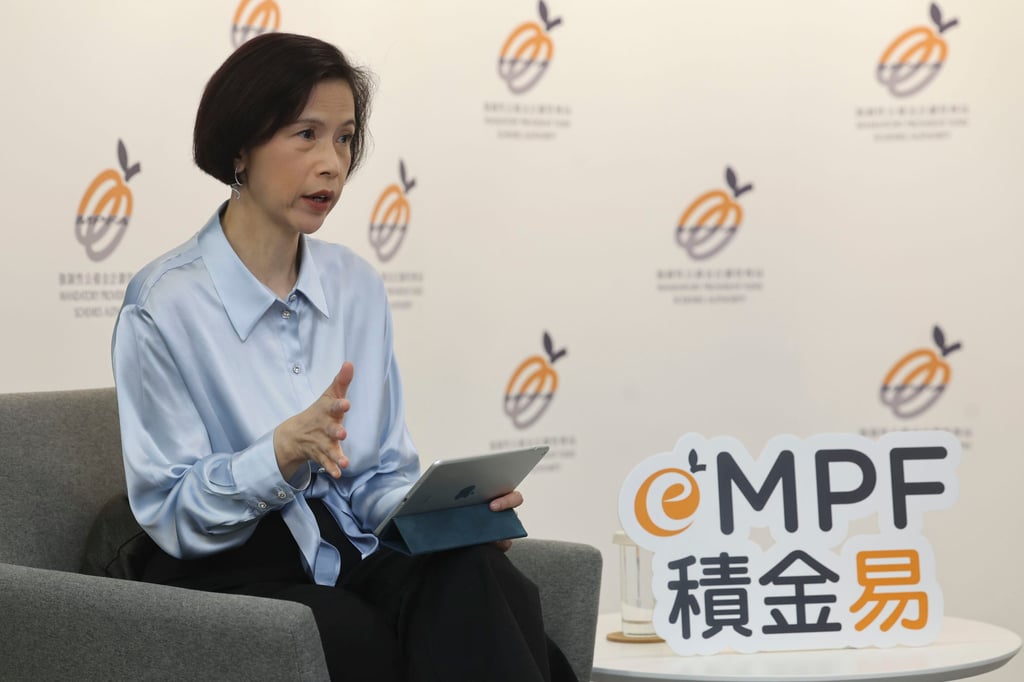Hong Kong will undertake further reforms to the Mandatory Provident Fund (MPF) to enable employees to switch service providers and widen real estate investment trust (Reit) choices following the successful introduction of the eMPF Platform.
The eMPF’s introduction in June has improved the administrative process while supporting the switching of MPF providers, Ayesha Macpherson Lau, chairwoman of the Mandatory Provident Fund Authority (MPFA), said in a small group interview.
In addition, the abolition of an offset mechanism that allowed bosses to dip into staff pensions to cover severance and long-service payments from May next year will also pave the way for introducing the so-called whole-free walk scheme, Lau said.
“After introducing the eMPF and the scrapping of the offset mechanism, it is the right time to study how to implement the ‘whole-free walk’ scheme to allow employees to switch their entire MPF mandatory contributions to a different provider,” she said.
Lau said the whole-free walk scheme will initially apply to those who change their jobs once the offset mechanism begins in May next year, while those who stay in their existing jobs could still bound by the old rule.

Established in 2000, the MPF is a compulsory retirement scheme that requires employers and employees to each pay 5 per cent of the salary, up to a combined HK$3,000 (US$385) a month, to one of 12 MPF providers.
A significant criticism of the MPF was that while it allowed employers to choose the provider, employees could not change the provider until 2012, when the Employee Choice Arrangement was introduced.
The scheme is commonly known as “semi-free walk” because it only allows the employees to transfer their accumulated mandatory contributions to a new provider once a year, but not those made by their bosses.
Employees have conducted about 1 million transactions under the “semi-free walk” scheme involving HK$47 billion (US$6 billion) since its launch 12 years ago, Lau said.
“The data showed there is a strong desire among employees to choose their providers,” she said. “When the employees can shift their entire MPF portfolio to the provider of their choice, it will increase competition and encourage the providers to cut fees and enhance their services and performance.”
Lau did not say when the “whole-free walk” scheme will be implemented as the requisite law needs to be amended.
The MPFA will also relax investment rules to allow MPF funds to invest in Reits listed in Shanghai and Shenzhen when they are added to the Stock Connect scheme.
In April, the China Securities Regulatory Commission said it would add Reits to the Stock Connect scheme, but the regulator has yet to announce the launch date.
The MPFA will also scrap the current cap for the MPF to invest only up to 10 per cent of assets in Reits listed in five markets, namely Japan, Singapore, France, Canada and the Netherlands, Lau said, adding that the timing for its implementation has not yet been decided.
“We believe Reits are a good investment choice as they can offer stable income to the MPF members. The [rule’s] relaxation will help improve the performance of the MPF,” she said.
Some HK$4.7 billion of funds have been invested in Reits as of March, representing 0.4 per cent of the total assets under the pension scheme, according to MPFA data.
The proposal to introduce the “whole-free walk” and expand the Reits investment programme comes after the launch of the eMPF Platform in June, which is expected to cut administrative costs by HK$30 billion to HK$40 billion over 10 years.
The eMPF Platform will replace separate systems currently used by different operators to allow providers, employers and employees to manage MPF payments, investments and other administrative work via the digital platform.
YF Life Trustees and China Life Trustees, the first two providers to join the platform, will start cutting their management fees in September and October, respectively.
Lau said the other 10 providers, which will gradually join the platform until the end of next year, will follow suit.
“We have already seen 13 investment funds starting to cut fees earlier this year even though the providers have not yet joined the eMPF Platform,” she said.


